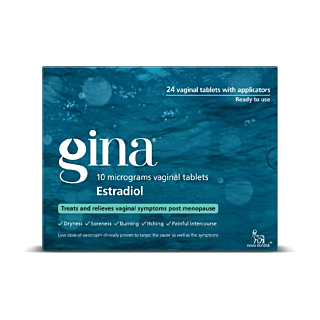Vaginal Dryness - Symptoms, Causes & Treatment

Vaginal dryness is a condition characterised by a lack of natural moisture and lubrication in the vaginal canal. It can occur due to hormonal changes, particularly because of a decline in oestrogen levels during the menopause.
Symptoms include discomfort, pain during intercourse, itching and an increased susceptibility to infections.
Treatment options include over-the-counter lubricants and moisturisers, hormone replacement therapy (HRT) for postmenopausal women, prescription medications, lifestyle adjustments, pelvic floor exercises and dietary supplements.
It's essential for those experiencing vaginal dryness to consult their GP for a proper diagnosis and personalised treatment plan.
Symptoms
Vaginal dryness brings about a set of uncomfortable symptoms. The most noticeable sign is a lack of natural moisture in the vaginal area, leading to dryness and discomfort.
This dryness can also cause itching and a burning sensation. During sexual intercourse, it often results in pain or discomfort, and sometimes even minor bleeding.
Furthermore, the dryness can make the vaginal tissues more vulnerable to infections, such as yeast infections or urinary tract infections (UTIs).
Causes
Vaginal dryness can be caused by several things, with hormonal changes being a main cause. Fluctuations in oestrogen levels during menopause, childbirth, breastfeeding or medication use can lead to a lack of natural vaginal moisture.
Additionally, certain medical conditions, such as autoimmune diseases or hormonal disorders, can contribute to vaginal dryness. Medications, emotional factors like stress, surgical procedures such as a hysterectomy, and chemical irritants can also be underlying causes.
Cancer treatments, ageing and even smoking have been associated with an increased risk of vaginal dryness.
Diagnosis
To diagnose vaginal dryness, healthcare providers follow a step-by-step process. It begins with an in-depth discussion of your symptoms and medical history, focusing on discomfort, dryness, itching and pain during sexual activity.
A physical examination, including a pelvic exam, is conducted to assess the condition of the vaginal tissues and identify any signs of dryness or abnormalities.
Blood tests may be ordered to check hormone levels, particularly oestrogen, which is often linked to vaginal dryness. Additionally, vaginal swabs or cultures may be collected to rule out infections.
Depending on your specific situation, further assessments like imaging studies or biopsies may be recommended.
The goal of this diagnosis is to pinpoint the underlying cause of the symptoms, enabling healthcare providers to recommend appropriate treatments tailored to your condition and alleviate any discomfort.
Treatment
Treatment for vaginal dryness depends on the underlying cause and can vary from person to person. Here are some common approaches to managing and treating vaginal dryness.
Lubricants and moisturisers
Lubricants and moisturisers are essential products for managing vaginal dryness and can enhance comfort during sexual activity and relieve dryness-related discomfort.
Water-based lubricants
Water-based lubricants are the most widely used and easily accessible option. They are compatible with latex condoms, safe to use with sex toys and generally hypoallergenic.
They are especially helpful during intercourse and can provide temporary relief from dryness.
Silicone-based lubricants
Silicone-based lubricants offer a longer-lasting, slippery texture compared to water-based options. They are also safe to use with condoms, but they may not be suitable for use with silicone sex toys, as they can degrade the material.
Hybrid lubricants
Hybrid lubricants combine the benefits of both water-based and silicone-based products. They offer longer-lasting lubrication while remaining safe to use with latex condoms. They are a good choice for those who want the best of both worlds.
Oil-Based lubricants
Oil-based lubricants, like coconut oil or mineral oil, can provide excellent lubrication but are not compatible with latex condoms. They can also be used for massage and moisturization but may not be suitable for all situations.
Vaginal moisturisers
Vaginal moisturisers are designed for long-term relief from dryness. They are applied directly to the vaginal area and can provide moisture for an extended period, making them suitable for daily use. These products typically do not interfere with sexual activity or condom use.
Hormone replacement therapy (HRT)
For postmenopausal women or those with severe hormonal imbalances, healthcare providers may recommend HRT.
This therapy can include oestrogen or a combination of oestrogen and progesterone delivered through various forms such as creams, tablets or vaginal rings. HRT helps restore vaginal moisture.
Gina is a vaginal tablet that treats the cause of vaginal dryness after the menopause without a prescription. It works by applying a small amount of oestrogen to the vagina, which can help to rebalance pH levels after 2 weeks, with symptoms improving after 8 weeks.
Prescription medications
In some cases, healthcare providers may prescribe specific oestrogen therapies tailored to address vaginal dryness. These may include oestrogen creams, tablets or vaginal rings. They are used to supplement natural oestrogen levels.
Lifestyle changes
Maintaining good vaginal hygiene, avoiding douching and engaging in regular sexual activity can help improve blood flow to the area and stimulate natural lubrication. Reducing stress through relaxation techniques may also be beneficial.






